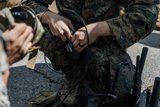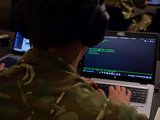Aviation commands facing greater demands (sponsored)
This article is brought to you by Frequentis
Supporting military missions
Military aviation commands around the world are facing more and more challenging demands associated with military missions, drone operations, increasingly stringent regulations and rising cost pressures. Improving the situational awareness is a crucial task for any ATC officer looking to ensure safety in air traffic control.
The ongoing digitisation of the industry offers opportunities to consolidate and improve the services while reducing costs and securing the most reliable equipment.
Frequentis offers wide-ranging ATC communication and automation solutions, which can be highly integrated, as well as completely modular. This enables military aviation commands to address their requirements for system upgrades or replacement while keeping the focus on mission fulfilment and safety assurance.
Secure communications
Military organisations and civil air authorities worldwide require trustworthy solutions they can rely on during both standard operation, as well as their missions. What is needed is field-proven technology that provides a 24/7, zero-fail availability, while handling multiple security domains. The Frequentis iSecCOM solution provides seamless integration into an IP infrastructure and meets both security and safety requirements for mission-critical tactical and operational command and control. iSecCOM supports the integration of voice communication systems, gateways including telebriefing and tactical data link voice integration, GFE/Crypto integration, legacy phone support and radio gateways.
We are extremely proud to be supporting the U.S. Navy with secure and effective voice communications for its MQ-25A Stingray UAS. The MQ-25A Stingray will be the first operational, carrier-based unmanned aircraft and will provide an aerial refueling capability to the carrier air wing (CVW), extending global reach and operational capabilities.
Boeing MQ25 © Boeing
Air traffic control
During a military operation that needs a lot of air power, many aircraft may need to arrive or depart an area within a short time frame, putting considerable strain on limited ATS resources. Traditional ATC towers could be an attractive target for attack, placing the controllers at risk, as well as potentially denying ATS. This is where a digital remote tower (RT) offers significant operational benefits, because the remote element of the system enables operators to continually maintain ATS services at a distance from potential threats. In one of RTs most simple configurations you can take deployable cameras in the back of a Humvee, put the cameras up and sit miles away in a shelter. For austere runways with little infrastructure, a basic system could be operational within hours.
The US DoD was the first to see the benefit of such a solution, selecting Frequentis to provide two fixed systems and two deployable systems to support the Air Force and other DoD agencies in October 2018, beating strong international competition. Frequentis also offers further RT system enhancements, including drone detection, surveillance sensors, asset tracking, and surveillance fusion.
Situational awareness
Aside from working across different military commands, modern forces recognise the need to share information with non-military organisations including public safety, civil aviation, maritime organisations, as well as governmental and non-governmental organisations (NGOs).
A common operational picture is fundamental to allowing real-time intelligence and tactical decision-making and in turn supporting the sharing of resources.
— Frequentis
There are a multitude of command and control systems (C2) in use today with varying levels of functionality that often cannot interact with each other. A common operational picture is fundamental to allowing real-time intelligence and tactical decision-making and in turn supporting the sharing of resources. The best way to manage any emergency is for all contributing response services to work together to improve response times and coordinate resource allocation.
The Frequentis framework is a group of shared situational awareness solutions that can be tailored to meet customer needs in a scalable and evolving system. When integrated with the Frequentis state-of-the-art communication systems, it provides a unique cross-domain command and control tool. This is not just a concept, but a solution in use today. The National Air Policing Centre (NAPC) currently operational in Germany fuses numerous data sources from widely disparate military and civilian systems into a single, easy to use HMI that is coupled with a fully integrated red/black communication system. This gives unheralded access to red/black landline and radio communications together with ‘click-to-dial’ functionality.
Air policing, Joint Operations, Search and Rescue, Drone Detection and Cyber Defence are just some of the typical use cases which benefit.
More from Digital Battlespace
-
![EID to unveil new vehicle communication system at DSEI]()
EID to unveil new vehicle communication system at DSEI
The Portuguese company’s naval communications system is in service across more than a dozen countries. It has turned to its home nation for support in developing a new vehicle based C2 system.
-
![Chess Dynamics successfully demonstrates Vision4ce AI-driven tracker]()
Chess Dynamics successfully demonstrates Vision4ce AI-driven tracker
The Vision4ce Deep Embedded Feature Tracking (DEFT) technology software is designed to process video and images by blending traditional computer vision with artificial intelligence (AI) algorithms to present actionable information from complex environments.
-
![Wave Relay devices cleared for security use on commercial systems in industry trend]()
Wave Relay devices cleared for security use on commercial systems in industry trend
Persistent Systems has been cleared by National Security Agency (NSA) to transmit sensitive data on commercial networks. The devices are added to the NSA’s Commercial Solutions for Classified (CSfC) component list which also includes other companies’ products providing the same security.
-
![UK teases cyber spending boost in Strategic Defence Review ahead of “imminent” release]()
UK teases cyber spending boost in Strategic Defence Review ahead of “imminent” release
The release of the UK’s Strategic Defence Review (SDR) has been long promised as mid-year. It is possible it could be as early as 2 June although the UK Ministry of Defence (MoD) continues to play its cards close to its chest.
-
![Intelsat emphasises SATCOM resilience for SOF in contested domains (video)]()
Intelsat emphasises SATCOM resilience for SOF in contested domains (video)
Intelsat outlines how its multi-orbit SATCOM architecture is enhancing connectivity and resilience for special operations forces operating in degraded and contested environments.
-
![US Space Force’s next-generation missile warning system moves forward with $500 million in new contracts]()
US Space Force’s next-generation missile warning system moves forward with $500 million in new contracts
Next-Generation Overhead Persistent Infrared (Next-Gen OPIR) satellites are intended to provide early warning of missile launches from any location worldwide and new ground stations will result in expanded coverage of critical missile warning.

























